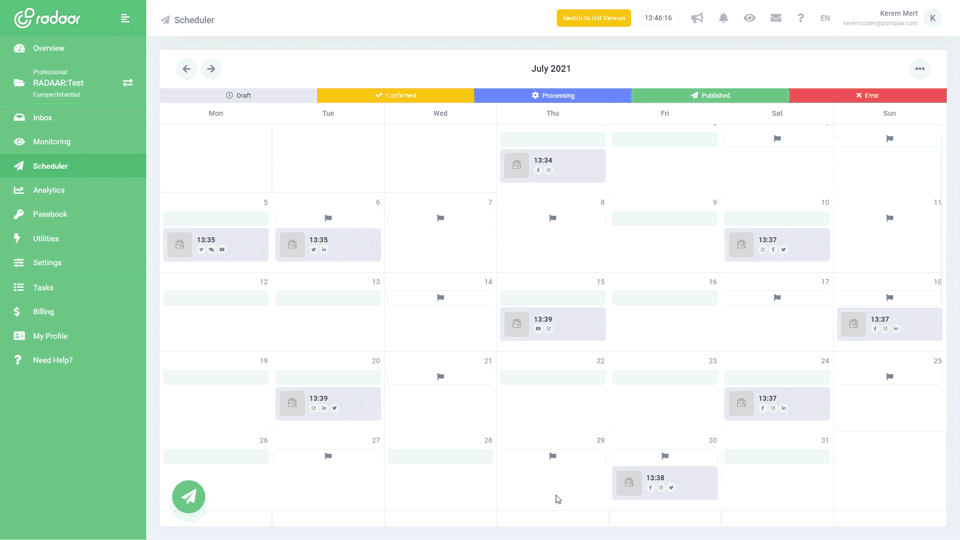Are you ready to master the art of creating a social media content calendar in 2024?
Dive into our latest blog post to unlock the secrets of mastering a social media content calendar in 2024, with step-by-step guidance and actionable tips. Ready to elevate your social media strategy and stay ahead of the game? Read on!
LEARN MORE LAUNCH DEMO NOW Are you ready to master the art of creating a social media content calendar in 2024? As social media continues to evolve, staying organized and ahead of trends has never been more crucial. A well-structured content calendar can save you time, maximize your reach, and ensure a consistent and strategic online presence. Whether you're a seasoned marketer or just starting out, understanding the latest tools and techniques is essential for success in the ever-changing digital landscape.
In this blog post, we'll dive into everything you need to know to build a killer social media content calendar for the new year. From setting clear goals and identifying your target audience to choosing the right platforms and scheduling your posts, we've got you covered. We'll share expert tips, best practices, and even some handy templates to help you streamline the process. So, let's get started on this journey to becoming a social media calendar pro in 2024!
In this blog post, we'll dive into everything you need to know to build a killer social media content calendar for the new year. From setting clear goals and identifying your target audience to choosing the right platforms and scheduling your posts, we've got you covered. We'll share expert tips, best practices, and even some handy templates to help you streamline the process. So, let's get started on this journey to becoming a social media calendar pro in 2024!
Table of Contents
- Why is a social media content calendar essential?
- What tools can you use for planning?
- How to determine your audience's preferences accurately?
- What type of content should you prioritize?
- How to set realistic and achievable goals?
- What are the best practices for scheduling posts?
- How to measure the success of your content?
- How to adjust your calendar based on feedback?
- Achieve social media success with a strategic content calendar
Why is a social media content calendar essential?
Creating a social media content calendar is essential because it keeps your content organized and ensures a consistent posting schedule, which is crucial for audience engagement. By planning ahead, you can strategically align your posts with important dates, promotions, and industry trends, maximizing your reach and impact. It also helps you balance different content types, ensuring a mix of promotional, educational, and entertaining posts. Plus, having a calendar allows for better collaboration with your team, streamlining the content creation process and avoiding last-minute scrambles.
What tools can you use for planning?
When it comes to planning your social media content calendar for 2024, a plethora of tools can make the process seamless and efficient. Trello or Asana offers an intuitive drag-and-drop interface perfect for visual planners, while Hootsuite and Buffer provide robust scheduling features that can handle multiple social accounts. Google Calendar remains a go-to for those who appreciate straightforward, time-based planning and real-time collaboration. Leveraging these tools helps ensure that your content strategy stays consistent and effective throughout the year.
How to determine your audience's preferences accurately?
To determine your audience's preferences accurately, start by delving into analytics from your current social media profiles to see what types of content are getting the most engagement. Conduct surveys and polls directly on your social platforms to gather firsthand information on what your audience wants to see more of. Additionally, use social listening tools to monitor discussions and trends related to your industry or niche. By combining these data-driven insights with a bit of competitive research, you'll have a well-rounded view of what resonates with your followers.
What type of content should you prioritize?
When creating your social media content calendar for 2024, prioritize content that engages, educates, and entertains your audience. Focus on high-quality visuals, such as images and videos, which tend to capture attention more effectively. Be sure to mix in time-sensitive content like trending topics and holidays to stay relevant and timely. Lastly, prioritize user-generated content and interactive posts to foster a sense of community and encourage audience participation.
How to set realistic and achievable goals?
Setting realistic and achievable goals for your social media content calendar is crucial for maintaining consistency and motivation. Start by analyzing your current metrics to understand what is practically attainable, then break down larger objectives into smaller, actionable steps. Use the SMART criteria – Specific, Measurable, Achievable, Relevant, and Time-bound – to give structure to your goals and ensure they are attainable. Lastly, regularly review and adjust your goals as needed to stay aligned with your overall strategy and evolving market trends.
What are the best practices for scheduling posts?
Scheduling posts is more than just picking dates and times; it's about understanding your audience's behavior and leveraging analytics for optimal engagement. The first best practice is to use data to guide your timing. Most social media platforms offer insights that reveal when your audience is most active. Schedule posts during these peak times to maximize visibility and interaction. Additionally, it's a good idea to diversify your content across different days and times to reach various segments of your audience who may check social media at different intervals.
Another crucial aspect of scheduling is consistency. By maintaining a regular posting schedule, you build trust and anticipation among your followers. Tools like Hootsuite or Buffer can help you plan and automate your posts, ensuring you never miss a slot. Also, stay flexible and ready to adjust your schedule as needed. If a post isn't performing well, don't be afraid to reschedule or tweak it for better results. Engaging with your audience in real-time based on their feedback can significantly boost your social media presence.
Another crucial aspect of scheduling is consistency. By maintaining a regular posting schedule, you build trust and anticipation among your followers. Tools like Hootsuite or Buffer can help you plan and automate your posts, ensuring you never miss a slot. Also, stay flexible and ready to adjust your schedule as needed. If a post isn't performing well, don't be afraid to reschedule or tweak it for better results. Engaging with your audience in real-time based on their feedback can significantly boost your social media presence.
How to measure the success of your content?
Measuring the success of your social media content involves tracking key performance indicators like engagement rates, reach, and conversions. Start by analyzing metrics such as likes, comments, shares, and saves to gauge interaction levels. Additionally, keeping an eye on reach and impressions will help you understand how wide your content is spreading. Finally, monitor conversion rates to see how well your posts are driving actions like website visits or sales, ensuring that your efforts align with your overall business goals.
How to adjust your calendar based on feedback?
Adjusting your social media content calendar based on feedback is crucial to staying relevant and engaging. Start by regularly reviewing comments, messages, and analytics to identify trends and areas needing improvement. Be flexible and willing to shift content themes, posting times, or formats based on this valuable input. This iterative approach ensures that your content resonates with your audience and continually evolves to meet their needs.
Achieve social media success with a strategic content calendar
Mastering the art of creating a social media content calendar in 2024 will undoubtedly be a game-changer for your online presence. With a strategic content calendar, you can plan, organize, and execute your content more efficiently, ensuring consistency and relevancy across all your social media platforms. Not only will this approach allow you to stay ahead of important dates and trends, but it will also free up valuable time that you can invest back into engaging with your audience and refining your strategy.
By implementing a content calendar, you are setting yourself up for social media success. You'll be able to track performance, make data-driven decisions, and continually optimize your content for better engagement and reach. Remember, consistency is key, and a well-thought-out calendar helps you maintain that consistency. So, take the plunge, and start planning your social media content with precision and creativity—2024 is your year to shine online!
By implementing a content calendar, you are setting yourself up for social media success. You'll be able to track performance, make data-driven decisions, and continually optimize your content for better engagement and reach. Remember, consistency is key, and a well-thought-out calendar helps you maintain that consistency. So, take the plunge, and start planning your social media content with precision and creativity—2024 is your year to shine online!
SOCIAL MEDIA SCHEDULER
Plan and publish...
Plan and publish your content for Facebook, Instagram, Twitter, and LinkedIn from one simple dashboard.
LEARN MORE FREQUENTLY ASKED QUESTIONS
What is social media management platform?
RELATED BLOG POSTS
All the tips & tricks you'll need...
Get the fresh tips and tricks you'll need to ace social media marketing.













